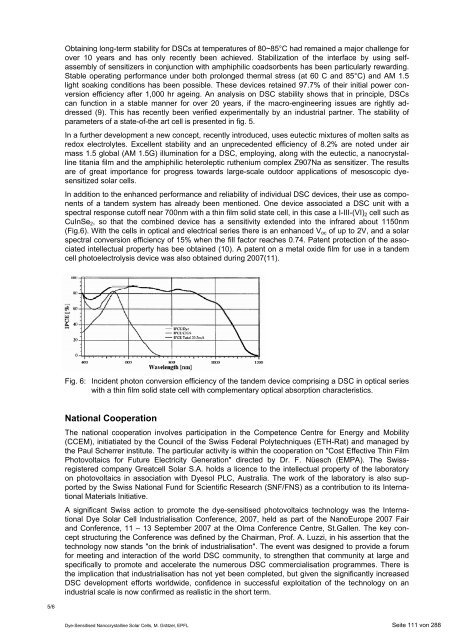Programm Photovoltaik Ausgabe 2008 ... - Bundesamt für Energie BFE
Programm Photovoltaik Ausgabe 2008 ... - Bundesamt für Energie BFE
Programm Photovoltaik Ausgabe 2008 ... - Bundesamt für Energie BFE
Create successful ePaper yourself
Turn your PDF publications into a flip-book with our unique Google optimized e-Paper software.
5/6<br />
Obtaining long-term stability for DSCs at temperatures of 80~85°C had remained a major challenge for<br />
over 10 years and has only recently been achieved. Stabilization of the interface by using selfassembly<br />
of sensitizers in conjunction with amphiphilic coadsorbents has been particularly rewarding.<br />
Stable operating performance under both prolonged thermal stress (at 60�C and 85°C) and AM 1.5<br />
light soaking conditions has been possible. These devices retained 97.7% of their initial power conversion<br />
efficiency after 1,000 hr ageing. An analysis on DSC stability shows that in principle, DSCs<br />
can function in a stable manner for over 20 years, if the macro-engineering issues are rightly addressed<br />
(9). This has recently been verified experimentally by an industrial partner. The stability of<br />
parameters of a state-of-the art cell is presented in fig. 5.<br />
In a further development a new concept, recently introduced, uses eutectic mixtures of molten salts as<br />
redox electrolytes. Excellent stability and an unprecedented efficiency of 8.2% are noted under air<br />
mass 1.5 global (AM 1.5G) illumination for a DSC, employing, along with the eutectic, a nanocrystalline<br />
titania film and the amphiphilic heteroleptic ruthenium complex Z907Na as sensitizer. The results<br />
are of great importance for progress towards large-scale outdoor applications of mesoscopic dyesensitized<br />
solar cells.<br />
In addition to the enhanced performance and reliability of individual DSC devices, their use as components<br />
of a tandem system has already been mentioned. One device associated a DSC unit with a<br />
spectral response cutoff near 700nm with a thin film solid state cell, in this case a I-III-(VI)2 cell such as<br />
CuInSe2, so that the combined device has a sensitivity extended into the infrared about 1150nm<br />
(Fig.6). With the cells in optical and electrical series there is an enhanced Voc of up to 2V, and a solar<br />
spectral conversion efficiency of 15% when the fill factor reaches 0.74. Patent protection of the associated<br />
intellectual property has bee obtained (10). A patent on a metal oxide film for use in a tandem<br />
cell photoelectrolysis device was also obtained during 2007(11).<br />
Fig. 6: Incident photon conversion efficiency of the tandem device comprising a DSC in optical series<br />
with a thin film solid state cell with complementary optical absorption characteristics.<br />
National Cooperation<br />
The national cooperation involves participation in the Competence Centre for Energy and Mobility<br />
(CCEM), initiatiated by the Council of the Swiss Federal Polytechniques (ETH-Rat) and managed by<br />
the Paul Scherrer institute. The particular activity is within the cooperation on "Cost Effective Thin Film<br />
Photovoltaics for Future Electricity Generation" directed by Dr. F. Nüesch (EMPA). The Swissregistered<br />
company Greatcell Solar S.A. holds a licence to the intellectual property of the laboratory<br />
on photovoltaics in association with Dyesol PLC, Australia. The work of the laboratory is also supported<br />
by the Swiss National Fund for Scientific Research (SNF/FNS) as a contribution to its International<br />
Materials Initiative.<br />
A significant Swiss action to promote the dye-sensitised photovoltaics technology was the International<br />
Dye Solar Cell Industrialisation Conference, 2007, held as part of the NanoEurope 2007 Fair<br />
and Conference, 11 – 13 September 2007 at the Olma Conference Centre, St.Gallen. The key concept<br />
structuring the Conference was defined by the Chairman, Prof. A. Luzzi, in his assertion that the<br />
technology now stands "on the brink of industrialisation". The event was designed to provide a forum<br />
for meeting and interaction of the world DSC community, to strengthen that community at large and<br />
specifically to promote and accelerate the numerous DSC commercialisation programmes. There is<br />
the implication that industrialisation has not yet been completed, but given the significantly increased<br />
DSC development efforts worldwide, confidence in successful exploitation of the technology on an<br />
industrial scale is now confirmed as realistic in the short term.<br />
Dye-Sensitised Nanocrystalline Solar Cells, M. Grätzel, EPFL Seite 111 von 288







